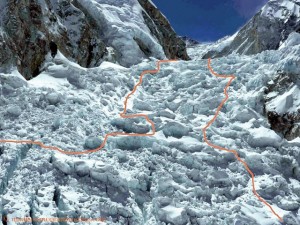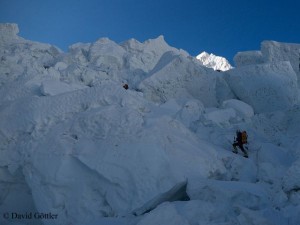Rather far on the right side
Apparently, the new route through the Khumbu Icefall is more than a little course correction. That is indicated by the images that the US guide Garrett Madison has published in his blog. Expedition members of his Madison Mountaineering team had flown over the icefall above Everest Base Camp by helicopter and had looked from the air where the so-called “Icefall Doctors” set up the route for this spring season. The images show that the route leads – seen from below – much further to the right side of the ice labyrinth than expected. Closer to Nuptse, further away from the West Shoulder of Everest, from where an ice avalanche had released on 18 April 2014 that had killed 16 Nepalis. “It appears that climbers will have to negotiate broken ice as before, and perhaps more vertical ladders”, Garrett wrote adding that there was at least one section that had four vertical ladders tied together to ascend up a very large ice cliff. This year, the famous US climber and filmmaker David Breashears, who scaled Everest five times, has advised the eight Sherpas to find a path through the icefall that is as safe as possible.
Environmental organization with a special task
The “Icefall Doctors” do not only set the route but also ensure that it remains accessible throughout the climbing season. Without their work it would be impossible for most of the Everest aspirants to pass the Icefall. These highly specialized Sherpas are selected and paid by the Sagarmatha Pollution Control Committee (SPCC), an organization that originally only cared about the environmental protection in the National Park around Mount Everest. Since 2000, the SPCC on behalf of the Government of Nepal is also responsible for the route through the Khumbu Icefall. It collects US $ 600 per expedition member. The amount has become an important part of SPCC’s income.
Indispensable, endangered, underpaid
“Unfortunately all these funds are not used in paying the Icefall Doctors or on equipment for the Icefall”, New Zealand expedition operator Russell Brice said last year. Those Sherpas who take the greatest risks because they have to move in the glacier every day are paid only about $ 2,000 per season. For comparison: Climbing Sherpas can, including bonuses, earn $ 4,000 to 6,000 $, those who reach the summit repeatedly make up to $ 10,000. The “stars” among the Sherpas allegedly take back home even up to $ 25,000 after a successful season.
No fall in demand
The government in Kathmandu announced that it released Everest permits for 30 expeditions this spring. Thus again some 300 foreign climbers will attempt to climb the highest mountain on earth from the Nepalese south side. That makes already clear that the “Everest market” in Nepal has not collapsed, despite the avalanche disaster in April 2014 and the subsequent early end last year’s climbing season.









